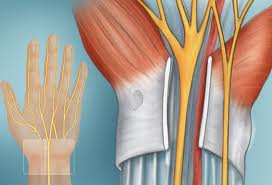
What is the median nerve entrapment syndrome?
The median nerve entrapment syndrome, also known as carpal tunnel syndrome, is the most common nerve entrapment syndrome on the upper limbs. The median nerve is usually entrapped or else compressed by the transverse joint of the wrist and the tendons of the flexor muscles of the hand within the carpal tunnel. It is usually common in middle-aged patients and it is four to nine times more prevalent in women. It affects both hands in more than half of the patients but it’s usually more frequent in the hand that is being used the most.
How is the median nerve entrapment syndrome caused?
There is usually not a specific cause. In younger patients, it can be caused by any of the following reasons:
- Congenital carpal tunnel stenosis
- Injuries related to work or hobbies that are caused by repeated wrist movements to uncomfortable positions such as overstretching, ulnar deviation, and abrupt wrist bending, with direct pressure on the carpal tunnel or by using tools that cause vibrations. Chronic stress of the hand has been observed to cause tenosynovitis to the tendons of the flexor muscles of the hand in a variety of professionals, such as farmers, breeders, builders, drivers, hairdressers, etc.
- Conditions, such as hypothyroidism, acromegaly, multiple myeloma, amyloidosis, rheumatoid arthritis, diabetes, polymyalgia rheumatica, obesity, pregnancy (usually a temporary effect) and puerperium, carcinomatosis, gouty arthritis, mucopolysaccharidoses, and tuberculous tenosynovitis
- Modern causes are the bad position of the wrist during typing on the computer as well as the use of estrogen receptor antagonists, such as Tamoxifen and anastrozole (Arimidex)
- Fistula in the forearm of patients on hemodialysis treatment
- Median nerve arterial thrombosis
- Hematoma formation within the carpal tunnel
The last two causes usually cause acute median nerve entrapment syndrome, which is manifested suddenly with intense pain after an injury or stress of the hand.
What are the main symptoms of the median nerve entrapment syndrome?
The symptoms of the syndrome vary from patient to patient and they are often not clear. Several patients claim that the pain starts from the shoulder and ends in the fingers. A typical symptom of the syndrome is the painful numbness of the hand that makes the patient wake up in the middle of the night and reflects to the elbow and often up to the shoulder. The patient moves the suffering hand up and down, opens and closes or rubs their fingers, or wets them with warm or cold water in order to relieve the pain. These symptoms can be manifested during everyday activities, such as holding a book or even a newspaper, during driving, or while holding the telephone on the patient’s ear. Pain and numbness are divided in three and a half fingers (thumb, index finger, middle finger, and half of the ring finger). Muscle weakness of the hand concerns mainly holding (things can fall from the hands) and in neglected cases, it may be accompanied by thenar eminence atrophy. Specifically, the patient is unable to use their thumb and thus execute fine movements, like buttoning a shirt. In 80% of the cases, wrist hyperextension for 30–60 seconds causes the symptoms (Phalen test). Finally, a light finger push to the transverse joint causes pain or numbness of the hand (Tinel’s sign) as well as the tourniquet bandage on the wrist for 30–60 seconds (Tourniquet test).
Which other conditions have similar symptoms to the median nerve entrapment syndrome?
Conditions causing similar symptoms that can confuse the diagnosis are:
- Radiculopathy, especially on the sixth neck nerve root (A6), which usually coexists along the median nerve entrapment syndrome (Double crush syndrome)
- Thoracic outlet syndrome
- Pronator teres syndrome (compression neuropathy of the median nerve at the elbow)
- De Quervain syndrome (tenosynovitis on the wrist)
- Reflective sympathetic dystrophy
- Tuberculous or fungal tenosynovitis of the flexor muscles
Which medical test is required for the diagnosis of the syndrome?
An electromyogram and an electroneurogram are required for the definition of the motor and sensory (more sensitive) speed of the median nerve in the wrist. These are compared with the respective ones of the ulnar nerve. However, in one third of the cases, the electromyogram comes back with normal rates.
Which medical test is required in order to exclude the possibility of a systematic disease that is manifested through the median nerve entrapment syndrome?
A range of medical tests is required when there is a possibility of a systematic disease occurrence.
Some of them are:
- Thyroid hormones (Τ3, Τ4, ΤSH) to exclude hypothyroidism
- Hematocrit and hemoglobin: anemia is frequent when there is a multiple myeloma and amyloidosis
- Potassium and sodium to exclude chronic liver failure that causes uremic neuropathy
- Blood glucose to exclude diabetes
- 24-hour urine sample for Bence-Jones protein that is manifested with the multiple myeloma
- Protein electrophoresis and immunoelectrophoresis to find the protein chains IgG antibodies
- Skeleton x-rays to exclude multiple myeloma
How is the median nerve entrapment syndrome classified based on its severity?
Clinical and electrophysiological findings define the classification of the syndrome based on its severity in three stages:
- Stage Ι: Light severity
- Stage ΙΙ: Medium severity or existing syndrome with both clinical and electroneurographic findings
- Stage ΙΙΙ: Heavy severity or neglected syndrome with thenar eminence atrophy
What is the conservative treatment of the median nerve entrapment syndrome and when is it indicated?
Conservative treatment is initially applied to the new incidents of light severity as well as the cases that are expected to be improved after the cause treatment (e.g., the clinical picture of hypothyroidism is improved after administration of thyroxin).
Conservative treatment includes:
• Resting of the limb
• Nonsteroidal anti-inflammatory medication
• Use of brace for neutral posture of the hand for 2–4 weeks: this improves the manifestation of the symptoms on half of the patients
• Cortisone administration in the carpal tunnel at Stage ΙΙ: it is advised to avoid it as it may cause further damage of the median nerve
When is surgical treatment indicated?
Surgical treatment is required:
- In cases that don’t improve with the conservative treatment
- When there is significant loss of sensation in the hand
- When thenar eminence atrophy is manifested
- When it is caused by multiple myeloma
Which surgical techniques are applied in the median nerve entrapment syndrome treatment? Link στη Θεραπεία του συνδρόμου μέσου νεύρου
The definite treatment of the syndrome is surgical and is done by the opening of the transverse joint and the decompression of the median nerve. This can be achieved either with an incision of 3–4 centimeters in length on the palm surface of the wrist, or endoscopically with one or two incisions.
What is required during postoperative recovery?
After the operation, the patient should not use their hand intensively until the sutures are removed on the 15th day postoperatively. Light physical therapy on the hand is applied right after the operation as well as painkillers treatment, which is gradually discontinued as the postoperative pain subsides. A complete recovery is achieved after the first month postoperatively when the patient can also use their hand normally.






